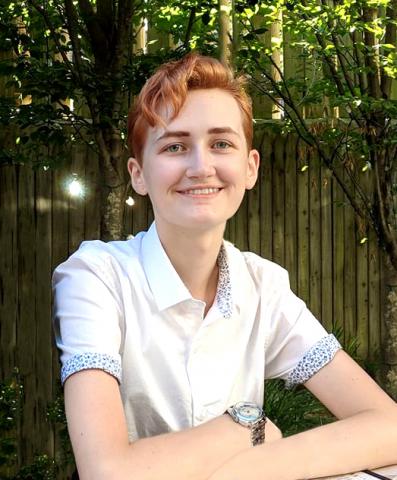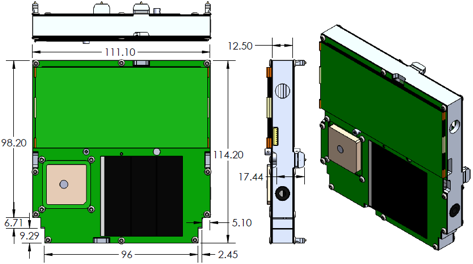Student Engineer Spotlight: Kimberly Frost
February 21, 2019Engineer’s week 2019 is here, and Capitol engineering students from all specializations are coming together to make it a great week full of learning, community, and geeking-out together.
Kimberly Frost is a first-year student at Capitol, but she’s already a sophomore. A scholar’s program student at her high school, Kim came to Capitol hefting credits from a wide array of AP courses. Studying everything from Music Theory and Literature to Calculus AB and BC, Kim loves video games, music, and using her knowledge to help others.
In Kim’s free time she plays almost any instrument with strings. Right now her favorite one to play is guitar. She is also heavily involved on campus in projects focused on her field of study, Astronautical Engineering. Kim participated in RockSatX, is a member of the CBEC team, and works as a co-lead on Capitol’s latest pico-satellite project, ThinSat.
We were lucky enough to snag some of her time to learn more about ThinSat and how Kim decided to get into Astronautical Engineering:
Q: So Kim, what made you decide you wanted to major in engineering?
KF: When I was younger I was really good at math. I’ve been in advanced placement since third grade and I was really bad at English and everything else comparatively, so my parents decided: Okay, we’re all just gonna go with it and we’re gonna fill your schedule with math.
And I really like math, so I thought that this path was really using everything that I’ve learned.
Q: Why Astronautical Engineering specifically?
KF: AE specifically is the coolest application of all the branches of engineering. You also get to learn a lot of programming with AE and both of my parents are really well versed in a bunch of different programming languages. For me, I just never understood programming so I thought that this might be a good opportunity to have better conversations with people I spend a lot of time with.
I have struggled with the programming so far but I spent a lot of time practicing over break and I’m getting better. All of ThinSat is programming so I was like, well you’re gonna have to learn sometime. It’s all in C and C++. I started learning on Python in my free time which is way easier. If someone tried to talk to me about the physical tech of a project though it just goes over my head still. I’m not there yet.
Q: Well, you have time. You don’t have to learn it all right away; it takes time to get that stuff down.
KF: I get a little impatient. I just want to have all the knowledge now so I can use it and then show others what I learned. I want to be able to spread it around.
Q: So tell me more about ThinSat.
KF: ThinSat is a picosatellite. The whole payload, for rough comparison, is going to be about the size of your phone. It has expandable solar panels for power and we have these chips the size of Cheese-It’s that tell it what to do. Each chip is labeled and does a different thing. Right now the project is divided into two teams. Gregory Patten and I lead team A, and then Zachary Chavez and Sarah run team B.
Q: What is team A up to right now?
KF: Team A works with Duval High School. We’ve been a little behind because of the snow. We’re just meeting with them next week for the first time. We want to get high schoolers involved and included in the field. ThinSat is specifically designed to be pretty simple to get more people involved. We don’t have a definite experiment planned out yet, but I know Greg and I were talking about potentially doing something based off of electromagnetics or something in that realm.
With the chips we already have available we don’t have to worry about getting parts, so we don’t have to worry about, well what kind of sensor do we want for this? What kind of sensor do we want for that? We’ve been able to skip that whole phase, which is amazing. So for phase one, we’re using the chips and sticking them together. You just plug it into a USB port on your laptop and then download and install some drivers so you can talk to the payload. The sensors will immediately start collecting live data once you get connected to the Wi-Fi. There’s also a little screen display which is just cool to see because you can look at it and say, okay it’s working.
All that data gets uploaded to the space data dashboard, which is what all of ThinSat runs through. It’s sponsored by TWIGGS and Virginia Space. Our kits are directly from TWIGGS who actually also sponsored the CubeSat. So we’ve really just flattened a CubeSat.
Q: And the goal is at some point to launch the payload?
KF: Yes. So originally we were going to get it done just this semester working with the high schoolers, but with the snow it’s been hard to get in contact with them. Our launch was actually also supposed to be in September, but it got pushed back to next spring. So we have more time.
Q: What are some of the major challenges of the ThinSat project?
KF: There’s so little documentation. We’re working with I think the second generation of this kit. This is really brand new tech. There’s some information out there, but some of it is out of date and it’s either not specific enough or it’s too specific for the first generation of chips which is slightly different than our generation of chips. It would be like put your IP01 chip, which is just the USB, flip some switches on it to set it to flashing – and ours don’t have switches on them. Or the previous generation would use CR03 radio module chips for the coms, but ours are using R103 which is Wi-Fi based. So there’s a lot of contradictory information. It’s been a lot of hours of reading and re-reading and parsing through information.
One good example, is the directions will be like put your weather Sat in your laptop, but then it won’t explain how to dismount it safely without frying the tech. When we first put it in I was working with Zachary from team B and we spent like an hour thinking just, do we eject this? We just looked at each other and said, well here goes nothing and just hoped it didn’t fry the chips.
It’s like they give you a car and say here’s the accelerator, but they don’t tell you where the break is. When you do finally press the break it isn’t working so you have to think on your feet to fix it.
Q: It sounds like this is a really challenging project. What about it appeals to you the most?
KF: Lead troubleshooting. I like finding a problem and fixing it.
I tried RockSatX last semester and I’m in CBEC as well. We always get stuck on the parts. Like the very beginning stages, and with ThinSat we were able to skip that and really get into the meat of things. So I can use that information I learned and if we don’t do ThinSat again or if I decide to move to a different project I can take that information with me.
Thank you Kim!
The ThinSat team currently has one spot still open on team A and two open spots on team B for any Capitol students that might be interested in joining. Email knfrost@captechu.edu or stop by the Fusion Lab to sign up!
Interested in AE? Check out Capitol Tech’s many engineering fields of study here!




